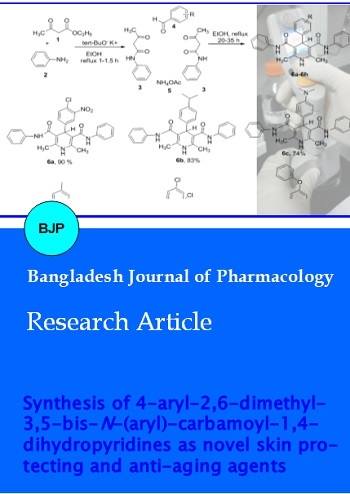Synthesis of 4-aryl-2,6-dimethyl-3,5-bis-N-(aryl)-carbamoyl-1,4-dihydropyridines as novel skin protecting and anti-aging agents
DOI:
https://doi.org/10.3329/bjp.v12i2.32023Keywords:
Anti-oxidant, 1, 4-Dihydropyridines, Elastase inhibition, SynthesisAbstract
A series of 4-aryl-2,6-dimethyl-3,5-bis-N-(aryl)-carbamoyl-1,4-dihydropyri-dines 6a-6h were prepared by using the one-pot three component synthetic method. The target compounds 6a-6h were synthesized by reacting two molar equivalents of ketone functionality and one mole of aromatic aldehydes in ammonium acetate to obtain the desired products. The structures of newly synthesized compounds were characterized by FT-IR, 1H-NMR, 13C-NMR, and elemental analysis. All the synthesized compounds were screened for their elastase inhibition and antioxidant activity. Almost all of the com-pounds 6a-h showed good to excellent activities against elastase enzyme more than the reference drug. Compounds 6d and 6b at 0.2 ± 0.0 µM and 0.2 ± 0.0 µM were found to most potent derivatives against elastase enzyme. Compound 6a exhibited prominent free radical scavenging activity. From the results of the biological activity, we infer that some derivatives can serve as lead molecules in pharmacology.
Video Clip of Methodology:
3 min 13 sec Full Screen Alternate
Downloads
158
154 Read
28

Published
How to Cite
Issue
Section
License
Authors who publish with this journal agree to the following terms:
- Authors retain copyright and grant the journal right of first publication with the work simultaneously licensed under a Creative Commons Attribution License that allows others to share the work with an acknowledgement of the work's authorship and initial publication in this journal.
- Authors are able to enter into separate, additional contractual arrangements for the non-exclusive distribution of the journal's published version of the work (e.g., post it to an institutional repository or publish it in a book), with an acknowledgement of its initial publication in this journal.
- Authors are permitted and encouraged to post their work online (e.g., in institutional repositories or on their website) prior to and during the submission process, as it can lead to productive exchanges, as well as earlier and greater citation of published work (See The Effect of Open Access).
